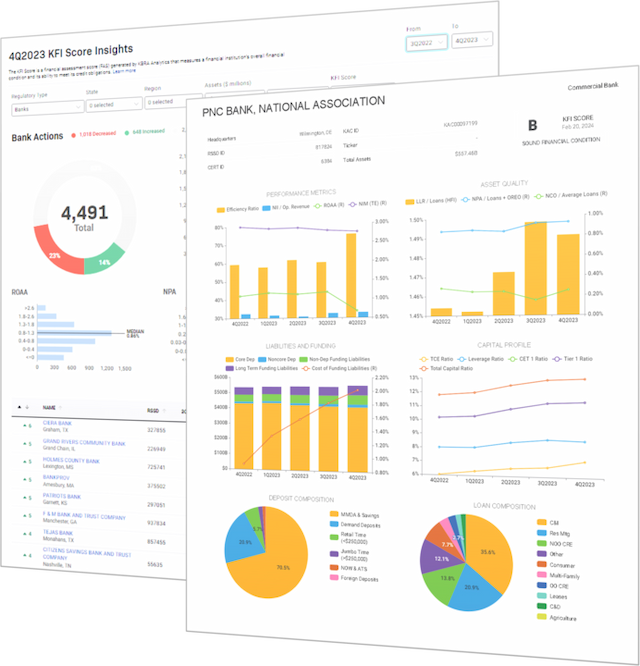KBRA Financial Intelligence
Banks May Cut More Jobs in AI-Driven Workforce Realignment
By KFI Staff
First Set of Earnings Fails to Halt Stock Selling
Several of the nation’s largest banks kicked off 3Q 2025 earnings season last week, including JPMorgan Chase & Co. (KFI Score: B+) and The Goldman Sachs Group, Inc. (KFI Score: B+), along with some smaller peers like Fifth Third Bancorp (KFI Score: B), all of which exceeded consensus expectations.
Reporting did not come without some turbulence, however. Comments regarding reserve builds, lending margin compression, and disclosures about troubled loans and several large write-downs ignited concerns among investors. The KBW Nasdaq Bank Index (BKX), which tracks the share prices of 24 publicly traded banks, ended the week to October 17 more than 7% off of a 2025 high reached in September. KBRA Financial Intelligence (KFI) data shows that the combined market capitalization of 320 publicly traded U.S. banks has declined by as much as $302 billion in the period since September 3.

AI-Induced Job Cuts Arrive in Banking
KFI has noted in previous Insights reports that commercial banks have been gradually shedding staff at an almost nonstop pace for several years. Since peaking in 1Q 2023, commercial bank head count has fallen by approximately 74,650 full-time employees—equivalent to a decline of 3.5%.

Some of the largest banks announced moderate job cuts throughout the first two quarters of earnings in 2025. Goldman Sachs—the 13th-largest U.S. bank in terms of head count, at 48,300 full-time employees—noted in a companywide memo that it would carry out a “limited reduction in roles across the firm.” These cuts are likely part of the latest phase of its operating model initiative called OneGS 3.0—meant to transform the firm with AI and “process reengineering”.
With the advent of AI and other technological efficiencies, it is possible that many of the jobs that banks have cut in recent years have been made redundant by tech deployments. If so, it is unlikely that those jobs are coming back, even if the labor market were to show renewed resilience in coming quarters. This broadly aligns with KFI’s recent analysis of hiring trends in banking, detailed in our September 30 webinar Fed in Flux: How the Banking Sector Will be Impacted.
Core Banking Has Been Epicenter of Cuts
Though Goldman Sachs has disclosed the effort to continue terminating roles, which will “constrain head count growth,” the net change in in the bank’s workforce should remain positive by year-end. This highlights a key divergence in bank hiring trends, which can be observed between the reported head count of bank holding companies (BHC) versus the underlying commercial banking industry.

For example, between 1Q 2023 and 2Q 2025, Goldman Sachs reduced the head count of its commercial banking subsidiaries by a net 567 employees, whereas full-time employment in noncommercial banking sections of the firm jumped by 1,067 throughout the same period. This trend can be observed throughout the broader banking space, which has seen commercial banking roles absorb the lion’s share of workforce consolidation among banks in recent years. BHCs’ nonbank affiliates are often dominated by securities firms, which include broker-dealers, asset managers, and investment advisers, as well as service companies focused on IT or data processing.
Several of the brightest spots in 3Q 2025 bank earnings have emerged from the corporate and investment banking (CIB) segment, such as surging income in institutions’ sales and trading businesses, as well as a long-awaited rebound in investment banking. If such robust growth is maintained, it is possible that further reductions to bank-related workforces remain concentrated within commercial bank operations.
